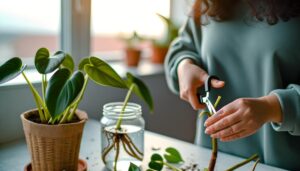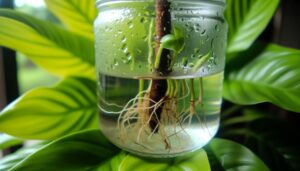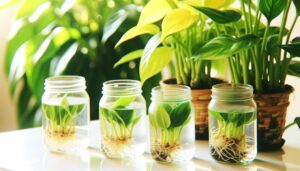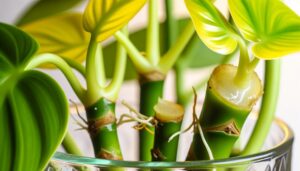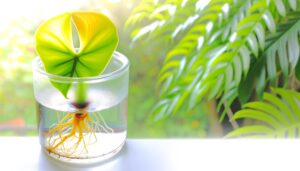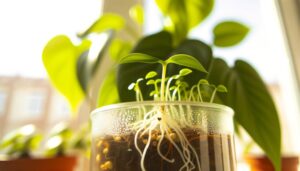How to Propagate Brazilian Philodendron: Easy Methods!
To propagate Brazilian Philodendron (Philodendron hederaceum), select healthy parent plants with vigorous growth. Use sterilized pruning shears to make clean cuts below a node on a disease-free stem.
Apply rooting hormone, such as indole-3-butyric acid, to promote root initiation. Place cuttings in water or well-draining soil, ensuring nodes are submerged.
Maintain ideal conditions: bright, indirect light, 60-80% humidity, and consistent moisture levels. Sterilize tools to avoid contamination.
Monitor environmental factors like temperature and light intensity for successful propagation. Understanding these detailed methods can greatly enhance your chances of robust growth and root development.
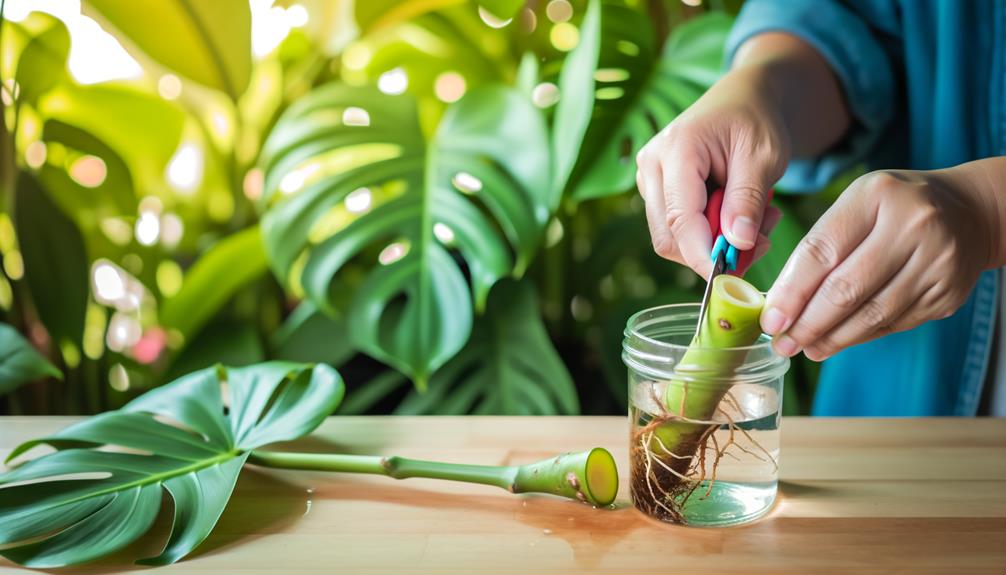
Key Takeaways
- Select Healthy Parent Plants: Choose vibrant, disease-free parent plants with strong growth for propagation.
- Cutting Preparation: Use sterilized pruning shears to make clean cuts below a node and apply rooting hormone.
- Rooting Methods: Submerge cuttings in water, changing it every 3-5 days, or plant in well-draining soil.
- Ideal Conditions: Maintain bright, indirect sunlight and 60-80% humidity for optimal growth.
- Watering and Transplanting: Keep the growing medium consistently moist with distilled water and use well-draining soil for transplanting.
Choosing Healthy Parent Plants
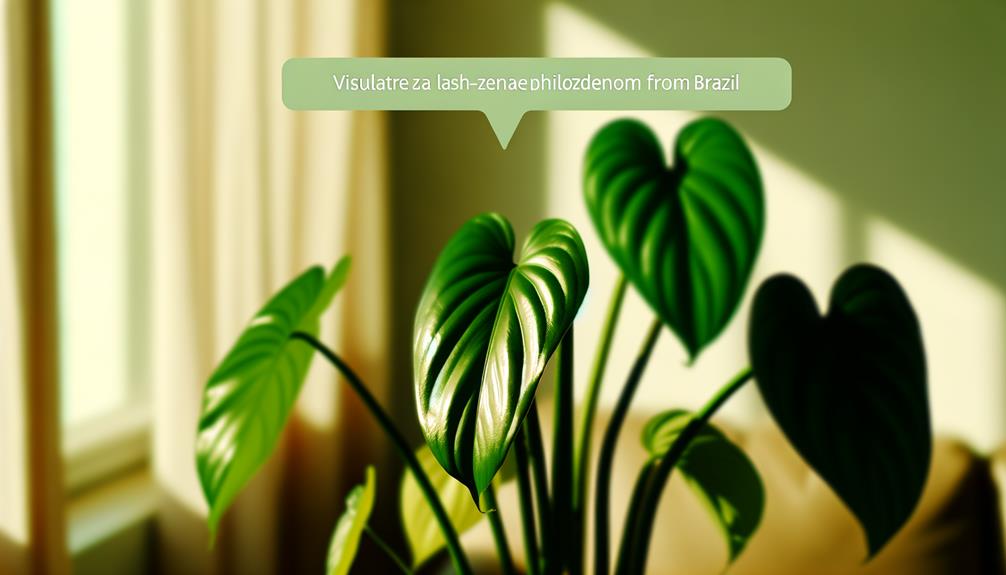
Choosing healthy parent plants is crucial for successful propagation of Brazilian Philodendron. This ensures the genetic vigor and disease resistance of the offspring.
Select parent plants showing strong growth, vibrant foliage, and absence of disease symptoms. Assess for common phytopathological issues such as leaf spots, yellowing, or wilting, which may indicate underlying infections.
Ensuring the parent plant’s best physiological state involves verifying adequate hydration levels, nutrient sufficiency, and absence of pests. Research underscores that propagation success rates correlate strongly with the health status of the parent plant, as stress conditions can impair cellular division and root development in cuttings.
Prioritize specimens acclimatized to the local environment to enhance resilience and adaptability in propagated offspring.
Necessary Tools and Materials
To propagate Brazilian Philodendron successfully, one must gather a collection of necessary tools and materials that facilitate precision and hygiene during the process. Key items include sterilized pruning shears for making clean cuts, reducing the risk of pathogen transmission.
A rooting hormone, preferably indole-3-butyric acid (IBA), can greatly enhance root development. Use clean, small pots filled with a well-draining, sterile potting mix to provide an ideal growth medium.
Transparent plastic bags or a humidity dome help maintain high humidity levels, essential for root initiation. Additionally, a sharp scalpel or knife, rubbing alcohol for sterilization, and a spray bottle for misting are indispensable.
Ensuring all tools are sanitized is essential to prevent contamination and promote healthy propagation.
Ideal Time for Propagation

The best time for propagating Brazilian Philodendron is during the active growing season, typically in the late spring to early summer, when the plant’s metabolic processes are at their peak.
During this time, the plant exhibits enhanced cell division and elongation, which facilitates successful root formation in cuttings. Environmental factors such as temperature, humidity, and light intensity also play essential roles in optimizing propagation success.
The table below summarizes the most favorable conditions for propagation:
| Factor | Ideal Condition |
|---|---|
| Temperature | 70-85°F (21-29°C) |
| Humidity | 60-70% |
| Light Intensity | Indirect, bright light |
| Soil Moisture | Consistently moist, not wet |
These conditions guarantee strong root development and minimize stress on the cuttings, promoting vigorous growth.
Preparing the Cuttings
Before initiating the cutting process, it is important to select healthy, disease-free stems that exhibit vigorous growth and have at least two to three nodes. This selection criterion ensures best propagation success and robust plant development.
Follow these steps to prepare the cuttings:
- Sanitize Tools: Use a sterilized, sharp knife or pruning shears to make clean cuts, minimizing the risk of infection.
- Cut Below a Node: Make the incision just below a node, as this area contains meristematic cells vital for root formation.
- Remove Lower Leaves: Trim off leaves near the cut end to prevent rot and promote root development.
- Apply Rooting Hormone: Dip the cut end in a rooting hormone to enhance root initiation and increase propagation success.
This careful preparation maximizes the likelihood of thriving new plants.
Rooting in Water
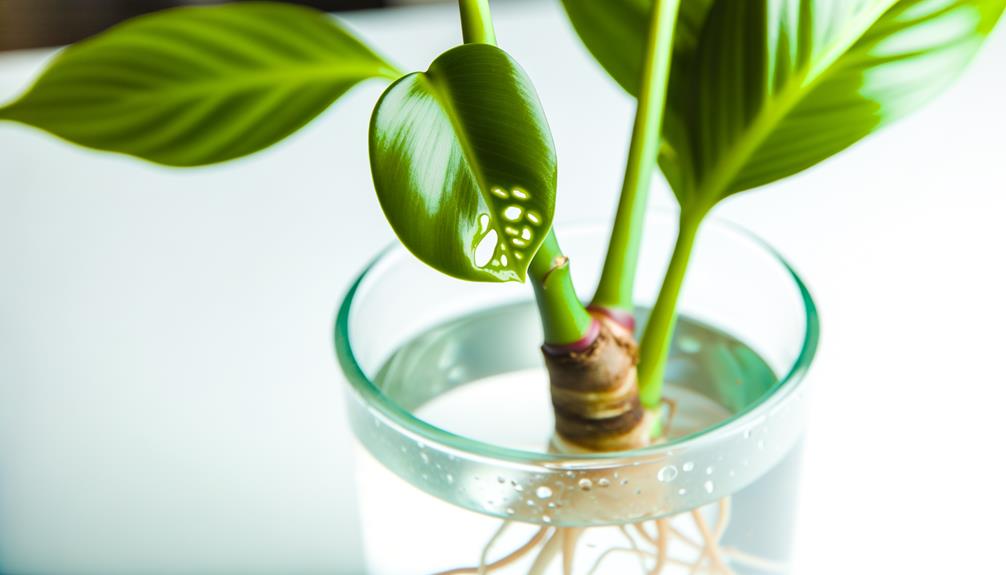
Once the cuttings are prepared, they can be placed in water to start root development, leveraging the plant’s natural tendency for hydroponic growth. This method involves submerging the node, from which roots will sprout, in a container filled with clean, room-temperature water.
It is important to make sure that only the node and lower part of the stem are submerged, while leaves remain above water to prevent decay. Regularly changing the water, ideally every 3-5 days, is necessary to prevent bacterial and fungal growth.
Light exposure should be indirect yet plentiful, as direct sunlight may cause overheating or algal proliferation. Typically, root formation is observable within two to four weeks, indicating the cutting’s readiness for transplantation.
Rooting in Soil
Rooting Brazilian Philodendron in soil requires a meticulously prepared soil mix that balances aeration and moisture retention. This mix typically incorporates components such as peat, perlite, and vermiculite.
Following soil preparation, the cuttings should be planted at an appropriate depth to guarantee contact with the soil while preventing rot.
Subsequent watering and care involve maintaining consistent moisture levels, avoiding waterlogging, and providing adequate light conditions to promote healthy root development.
Preparing the Soil Mix
Creating an ideal soil mix for rooting Brazilian Philodendron cuttings is necessary for successful propagation, requiring a well-draining medium rich in organic matter. The best soil mix promotes root aeration and moisture retention, vital for root development.
Research suggests the following components for a proficient soil mix:
- Perlite: Enhances aeration and drainage, preventing waterlogging which can lead to root rot.
- Peat Moss: Retains moisture while providing an acidic environment conducive to root growth.
- Compost: Supplies organic matter and essential nutrients, fostering healthy root development.
- Vermiculite: Balances moisture retention and drainage, offering a stable environment for young roots.
Planting the Cuttings
Carefully placing the Brazilian Philodendron cuttings into the prepared soil mix establishes the initial conditions necessary for successful root formation. Make sure each cutting has at least one node below the soil surface to promote root development.
The soil mix should be evenly moist but not saturated, maintaining an ideal balance for aeration and moisture retention. Position the cuttings vertically, guaranteeing they are stable and do not topple over.
| Step | Description |
|---|---|
| 1. Prepare Soil | Use a mix of peat, perlite, and compost for ideal aeration and moisture. |
| 2. Insert Cuttings | Place cuttings with nodes beneath the soil surface. |
| 3. Maintain Moisture | Keep the soil consistently moist but avoid waterlogging. |
| 4. Provide Support | Ensure cuttings are vertically stable and supported. |
| 5. Monitor Growth | Regularly check for signs of root emergence and overall plant health. |
This process promotes the essential conditions for root establishment and subsequent plant growth.
Watering and Care
Proper hydration is essential for the successful rooting of Brazilian Philodendron cuttings, necessitating a consistent yet measured approach to watering. Maintaining a regular yet controlled watering routine can greatly enhance root development while avoiding common issues such as root rot.
- Watering Frequency: Stick to a consistent watering schedule, ensuring the soil stays uniformly moist but not saturated. Generally, watering every 5-7 days is adequate.
- Soil Moisture Monitoring: Use a soil moisture meter to determine accurate hydration levels, aiming for moderate dampness.
- Drainage: Guarantee the potting medium has good drainage to avoid water buildup, which can result in lack of oxygen for roots.
- Humidity Control: Sustain high humidity levels around the cuttings, ideally between 60-80%, to promote hydration and root establishment.
This routine helps in creating a conducive environment for strong root development.
Providing Proper Light
Ensuring sufficient light for the Brazilian Philodendron is crucial, as it thrives in bright, indirect sunlight conditions that mimic its natural tropical habitat. Direct exposure to intense sunlight can lead to leaf scorch, while inadequate light results in leggy growth and diminished foliage health.
Utilizing a light meter can help determine the best light intensity, ideally between 10,000 to 20,000 lux. Positioning the plant near east-facing windows or using sheer curtains to diffuse sunlight is recommended.
Below is a table summarizing ideal light conditions:
| Light Condition | Description | Effects on Plant |
|---|---|---|
| Bright, Indirect | Filtered light, no direct rays | Optimum growth and health |
| Low Light | Minimal natural light | Slower growth, pale leaves |
| Direct Sunlight | Unfiltered sun rays | Leaf scorch, damage |
| Artificial Light | Full-spectrum grow lights | Satisfactory, if consistent |
| Fluorescent Light | Cool white fluorescent bulbs | Moderate growth |
Maintaining Humidity Levels
Maintaining best humidity levels is essential for the successful propagation of Brazilian Philodendron, with an ideal humidity range of 60-80% to mimic their native tropical environment.
Various tools such as hygrometers for precise humidity measurement and humidifiers to maintain consistent moisture levels can be employed.
Advanced techniques, including the use of humidity trays and misting, contribute to creating an environment conducive to root development and overall plant health.
Ideal Humidity Range
Achieving a perfect moisture range of 60-80% is crucial for the successful propagation of Brazilian Philodendron, as it guarantees sufficient moisture levels that support root development and overall plant health.
Maintaining this specific moisture range helps to mimic the plant’s native tropical environment, which is essential for its physiological processes. High moisture promotes transpiration and nutrient uptake, enhancing the formation of robust roots.
To maintain the best moisture levels, consider the following:
- Moisture Trays: Placing water-filled trays near the plants increases ambient humidity.
- Spraying: Regular spraying helps to elevate humidity around the cuttings.
- Moisture Domes: Using plastic domes retains moisture within a localized environment.
- Humidifiers: Deploying electric humidifiers ensures consistent moisture levels.
These methods collectively foster an environment conducive to healthy propagation.
Tools and Techniques
Utilizing specific tools and techniques is essential for maintaining ideal moisture levels crucial for the successful propagation of Brazilian Philodendron. Research indicates that an optimum moisture range of 60-80% greatly enhances root development and overall plant health.
Employing tools such as humidifiers and misting bottles can aid in achieving these conditions. Moisture domes or plastic covers can create a microenvironment that retains moisture effectively.
Monitoring devices, such as hygrometers, provide precise moisture readings, ensuring that levels remain within the desired range. Additionally, placing a tray of water near the plants increases ambient moisture through evaporation.
| Tool | Purpose |
|---|---|
| Humidifier | Maintains consistent moisture levels |
| Misting Bottle | Provides direct moisture to plant surfaces |
| Moisture Dome | Creates a controlled moist microenvironment |
| Hygrometer | Measures and monitors moisture levels |
| Water Tray | Enhances ambient moisture through evaporation |
Watering the Cuttings
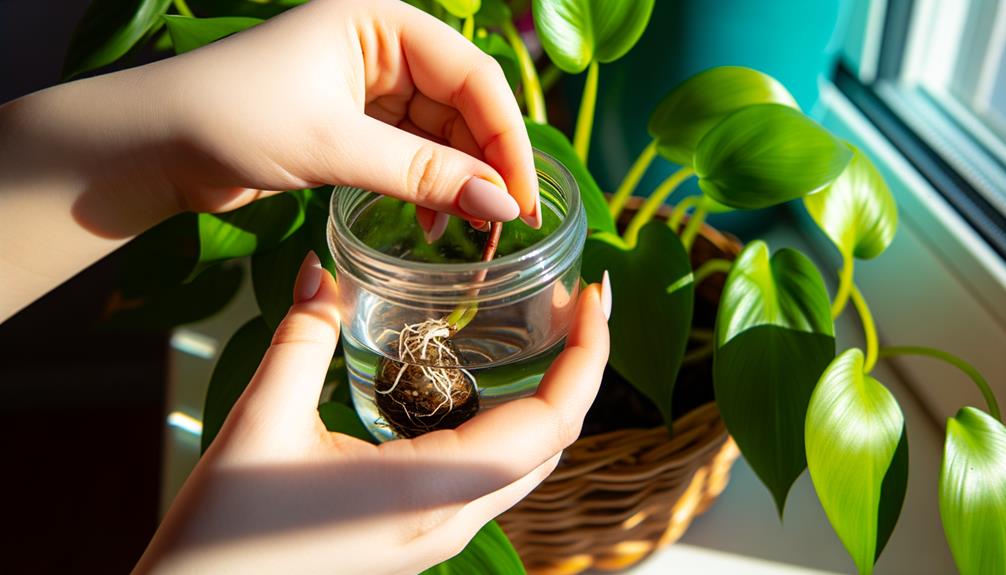
Promoting best hydration for Brazilian Philodendron cuttings involves maintaining a consistent moisture level in their growing medium, which is crucial for successful root development. Research indicates that ideal hydration facilitates cellular osmosis and nutrient uptake, thereby enhancing root initiation and elongation.
To achieve this, consider the following steps:
- Water Quality: Use distilled or rainwater to avoid chlorine and mineral build-up, which can hinder root growth.
- Moisture Consistency: Keep the growing medium consistently moist but not waterlogged to prevent root rot.
- Humidity Control: Maintain ambient humidity around 60-70% to replicate the plant’s natural tropical environment.
- Regular Monitoring: Check moisture levels daily using a moisture meter, ensuring the medium remains favorable for root development.
These practices promote optimal hydration, fostering robust root systems.
Transplanting New Plants
Transplanting new Brazilian Philodendron plants necessitates selecting a well-draining, nutrient-rich soil medium to promote best root development.
Employing precise watering techniques is critical to avoid root rot and guarantee the cuttings establish robust roots.
Additionally, maintaining appropriate light levels and temperature conditions will support healthy growth and prevent stress during the acclimatization period.
Choosing the Right Soil
Selecting the appropriate soil composition is crucial for the successful transplantation of Brazilian Philodendron, as it directly influences root development and overall plant health. Research indicates that these tropical plants thrive in well-aerated, nutrient-rich substrates. Vital soil should facilitate proper drainage while retaining sufficient moisture.
Key considerations for selecting soil include:
- Aeration: Incorporate materials such as perlite or orchid bark to improve air circulation within the soil matrix.
- Nutrient Content: Use a balanced potting mix enriched with organic matter to provide necessary nutrients.
- pH Level: Ensure the soil pH remains slightly acidic, ideally between 5.5 and 6.5, to optimize nutrient uptake.
- Drainage: Avoid waterlogged conditions by selecting a soil mix that includes components like peat moss and coarse sand for improved drainage.
These elements collectively guarantee robust growth and health of the Brazilian Philodendron.
Proper Watering Techniques
Proper watering techniques are essential when transplanting new Brazilian Philodendron plants, as they greatly impact root establishment and overall plant health. Initially, the soil should be uniformly moist but not waterlogged to facilitate root growth.
Overwatering can lead to root rot, a pathological condition detrimental to plant health. Conversely, underwatering can cause desiccation and impede root development.
Research indicates that maintaining a consistent moisture level, akin to a wrung-out sponge, enhances root respiration and nutrient uptake. Employing a well-draining soil mix, as previously discussed, aids in preventing excess moisture accumulation.
Regular monitoring of soil moisture, preferably using a soil moisture meter, can provide precise feedback, ensuring ideal hydration levels are maintained throughout the critical transplant phase.
Light and Temperature Needs
Ensuring ideal light and temperature conditions is essential for the successful establishment and growth of newly transplanted Brazilian Philodendron plants. Best environmental parameters greatly influence photosynthesis, respiration, and overall plant vigor.
Research indicates that Brazilian Philodendrons thrive in bright, indirect light and temperatures ranging between 65-80°F.
Below are critical guidelines:
- Light Intensity: Provide bright, filtered light; avoid direct sunlight to prevent leaf scorch.
- Temperature Range: Maintain ambient temperatures between 65-80°F to support physiological functions.
- Humidity Levels: Maintain relative humidity of 60-70% to replicate tropical conditions, enhancing leaf health.
- Seasonal Variations: Monitor seasonal temperature fluctuations, adjusting indoor conditions to align with plant needs.
These parameters are foundational for the robust growth of the Brazilian Philodendron.
Common Propagation Mistakes

Propagation of Brazilian Philodendron can be hindered by several common mistakes, such as improper cutting techniques and inadequate environmental conditions. One prevalent error is the selection of non-viable cuttings; it is essential to choose a segment with at least one node and healthy leaves.
Additionally, neglecting to use sterilized tools can introduce pathogens, leading to rot. Inadequate light and temperature also play a critical role; subpar conditions impede root development. Overwatering or underwatering can further stress the cuttings, hindering successful propagation.
Failing to provide proper humidity levels around 60-70% can result in desiccation of the cuttings. These issues, often overlooked, are fundamental to achieving robust growth and should be meticulously managed for the best propagation outcomes.
Conclusion
To sum up, the propagation of the Brazilian Philodendron, while seemingly straightforward, often demands a level of precision and attention to detail that rivals the complexity of quantum mechanics.
The rigorous selection of parent plants, meticulous preparation of cuttings, and exacting maintenance of humidity levels serve as a tribute to the plant’s aristocratic demands.
Indeed, the process transforms the humble gardener into a veritable horticultural scientist, demonstrating that even the simplest plants can require the most sophisticated care.

